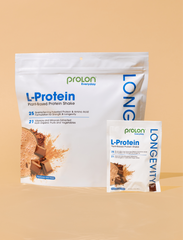
mTOR: What It Is and How it Affects Longevity
On your health and longevity journey, you may have heard mention of nutrient-sensing pathways. When activated by certain nutrients, these pathways send signals to various parts of the body, instructing them what to do, such as energy utilization, metabolism regulation, and cell growth or repair. Overstimulating such pathways may accelerate these processes, potentially leading to unwanted outcomes such as speeding up aging.
At L-Nutra, our fasting mimicking products were formulated to avoid triggering these pathways, making it possible for your body to stay in a fasting state, even while eating. Prolon’s 5-Day Fasting Mimicking Diet (FMD) tracks three specific nutrient-sensing pathways: IGF-1 (a protein pathway), PKA (carbohydrate pathway), and mTOR (amino acids pathway), which are important when we are young and growing, but may speed up aging in adulthood. mTOR, specifically, plays a major role in the body’s aging and growth processes, and when kept low between the ages of 18 - 65, is associated with longevity and healthspan, the period of life spent in good health.
mTOR- the story
At its core, mTOR is an enzyme that acts as a master regulator within the body. It plays pivotal roles in regulating many fundamental cellular processes like growth, metabolism, and protein synthesis.
The story of mTOR itself is fascinating: its inhibitor, a molecule that binds to an enzyme and decreases its activity, was discovered before it was! Isolated from soil on the island of Rapa Nui (Easter Island), a compound was found first to have antifungal activities, then immunosuppressive properties, and used successfully to reduce organ rejection with kidney transplantation. Soon, researchers began noticing there were less incidents of cancer in those taking this inhibiting compound (developed into a drug named rapamycin, after the island). Then, in 2009 its implication to potentially increase lifespan was discovered when researchers found that mice fed rapamycin lived an extra six months, equivalent to about 20 years in humans. The enzyme that rapamycin was inhibiting to produce these results, when ultimately identified, was named mTOR: the mechanistic (or mammalian) target of rapamycin.
How mTOR may speed up aging
When nutrients, particularly proteins and sugars, are abundant in the diet, mTOR activity spikes, prompting the cells in our body to divide and grow. We need this during childhood, as it is crucial for growth. However, as we get older, increased mTOR activity is linked with aging, neurological diseases, and malignancies. For example, mTOR is elevated in nearly 100% of advanced human prostate cancers, and higher mTOR expression has been noted in breast cancer tumors associated with more aggressive disease and lower survival rate among breast cancer patients. This has made mTOR inhibition a potential therapeutic target for these diseases.
An analogy often used likens mTOR to the engine of a car speeding recklessly without brakes. While beneficial in youth to drive growth, the activity of mTOR may turn into a liability in adulthood by accelerating aging. Historically, humans and other animals didn't live as long as we do today; thus, evolution did not equip us with natural "brakes" for this growth engine, which means it's up to us to find ways to slow it down ourselves.
How to slow down mTOR
While the drug rapamycin (known as Sirolimus) inhibits mTOR, it has an extensive list of side effects including stomach pain, headache, nausea, diarrhea, constipation, and joint pain, and its widespread use for anti-aging purposes faces challenges due to risk tolerance. However, targeted dietary approaches may play positive roles in regulating these pathways and offer safe “brakes” that are effective for both short- and long-term use.
-
Caloric restriction
One effective “brake” that has evolved over time is caloric restriction. Reducing calorie intake, particularly from sugars and animal proteins, has been shown to inhibit mTOR. This response may have evolved to allow organisms to enter a high protection mode when not enough food was available or sufficient for growth or reproduction. When mTOR detects that food is scarce, it slows down cell division and initiates autophagy, the body's way of cleaning house by removing damaged cells and recycling parts for future use - a process vital for cellular health and longevity. Prolon's 5-Day Fasting Mimicking Diet is the only program clinically proven to induce this state of autophagy.
-
Low protein diet, emphasizing plant-based foods
In both mice and humans, a low-protein diet has shown a reduction in growth factors. Because foods that can trigger mTOR are high in protein, particularly animal products rich in the amino acid leucine such as meat, fish, dairy, eggs, and high-glycemic carbohydrates such as refined grains and sugary foods and drinks, a diet low in animal protein and rich in plant-based foods - including plant-based proteins- may reduce mTOR activation.
Foods such as broccoli, green tea, soy, turmeric, grapes, onions, strawberries, blueberries, mangoes, and cucumber skin all contain natural mTOR inhibitors. Incorporating these foods into your diet, along with following the recommended cycles of Prolon’s 5-Day FMD (three consecutive months initially, followed by three times yearly) can help manage mTOR activity, supporting your longevity.
With the right dietary approaches, like Prolon’s 5-Day FMD, we can turn mTOR from the engine driving us toward accelerated aging into a tool for longevity!
Additional sources:
Bartke et al., 2013
Blagosklonny, 2013
Gregor, 2015
Harrison et al., 2009
Jung et al., 2013
Longo, et al., 2022
Melnik, et al., 2012
Mirisola et al., 2014
Pallavi, et al., 2012
Panwar, et al., 2023
Saxton, et al., 2017
Seto, 2012
Wang et al., 2016
Wazir, et al., 2013
Zoncu, et al., 2011













